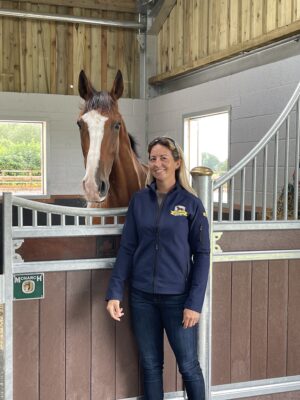Handy top tips on clipping from the professional Absorbine Ambassadors – Jayne Ross, Kevin and Emma McNab and Natalie McGoldrick.
Emma and Kevin McNab: International event riders
Kevin is an Olympic silver medal winner at the Tokyo 2020 Olympics as part of the Australian Event Team. He also has an enviable record of top 10 finishes at CCI5*, coming 6th at Kentucky in April 2021.

Emma has an impressive tally of top placings and has represented Australia on several occasions including at the World Equestrian games in 2018
Clipping:
Clipping is a practised skill but one everyone can master it. Once you have done it a few times it’s a very straight forward job. These are a few tips which we believe are important and make the difference between a good and bad clip.
-
- A clean coat is the first step. Not only does it result in a cleaner clip it is also much kinder on your blades, and they will stay sharper longer. We always give our horses a full bath in Absorbine 2 in 1 shampoo before they are clipped. We have found this gives fantastic results.
-
- The most common clip we do on our horses is the Hunter clip. So, we leave their legs and saddle patch on. It is important when clipping the outline of the saddle patch that you leave enough hair that the saddle actually sits on the patch with hair and not hanging out past it. If you do this, it is very common to get patches behind the saddle patch where the hair rubs and can sometimes make bald patches. This can make their backs quite sensitive and sore. The easiest way to make sure you don’t make the saddle patch too small or short is to sit a saddle cloth on their back and gently let it move to where it sits when you are riding. Then make a note of how far back you must make your saddle patch go.
-
- Try to clip in good light. Often if you clip in poor lighting, you bring the horse out into the natural light and notice you’ve missed spots.
Jayne Ross 5-time RIHS Supreme Champion and 7-time HOYS Supreme Champion
Hogging:
If you want to show your cob, you will need to hog his mane. Cobs have a workmanlike head and neck which is why hogging suits them so well.
Polo ponies and driving horses are also hogged to stop the mane becoming entangled in the equipment used with them. Other people hog their horse’s mane to help manage sweet itch as it makes it easier to apply treatments and prevents the horse rubbing its mane out.

-
- It is best to use battery -powered clippers. Try to use the quietest pair you can because you will be working right up to and through his ears. Do not use small trimers are they will not be powerful enough. Make sure your clippers are clean and the blades are sharp.
-
- Ensure you have a perfectly clean and dry mane before you start. A long mane should be cut shorter with scissors first and prevent the clippers overheating. Be positive using even pressure – do not use light, tickly strokes.
-
- Ideally hog the mane about 3 days before a show as this allows for a bit of regrowth so your horse will not look scalped because he will on day one! Applying ShowSheen Miracle Groom waterless shampoo after you have hogged is a good way to lift out any greasy residue, dirt and dust.

Whatever your reason for hogging make sure to take the time to ensure your horse is happy with the noise of the clippers before you start the process.
Natalie McGoldrick MA VetMB MRCVS – Equine vet and event rider
Natalie graduated as a Vet from the University of Cambridge and went on to set up her own practice. She is an advanced level event rider having represented GB on the team at 3* and has produced horses up to 4*

As an equine vet, I spend a lot of time clipping, albeit on a small scale, for things such as prepping for joint injections, or to better examine wounds. I am also frequently asked to sedate nervous horses so that they can be safely clipped. These are my top clipping tips from a veterinary viewpoint.
-
- If having your horse sedated by a vet for clipping, make sure you have everything ready to go! Don’t discover that your blades need sharpening, or the yard plug socket isn’t working, after the vet has sedated your horse! Also be aware that horses often sweat when they have been sedated, which may make clipping certain areas quite tricky.
-
- Remember that even when sedated, a horse can still kick! If your horse is prone to kicking out when being clipped in sensitive areas, don’t presume he isn’t going to kick when sedated; his reactions will just hopefully be a bit slower!
-
- If you have a horse or pony with Cushings, he or she will likely need clipping throughout the summer months. Likewise, any horse or pony with a thick coat will also be more comfortable if clipped all year round, especially if they are in work. Remember to keep pink skin covered during the heat of the day if you do clip, to prevent sunburn. A spritz of ShowSheen Hair Polish and Detangler onto the hair will help clippers glide through quickly.


